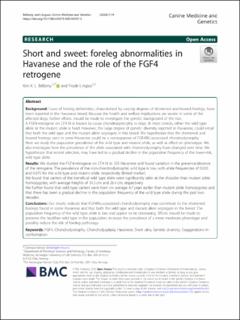| dc.description.abstract | Background: Cases of foreleg deformities, characterized by varying degrees of shortened and bowed forelegs, have been reported in the Havanese breed. Because the health and welfare implications are severe in some of the affected dogs, further efforts should be made to investigate the genetic background of the trait. A FGF4-retrogene on CFA18 is known to cause chondrodystrophy in dogs. In most breeds, either the wild type allele or the mutant allele is fixed. However, the large degree of genetic diversity reported in Havanese, could entail that both the wild type and the mutant allele segregate in this breed. We hypothesize that the shortened and bowed forelegs seen in some Havanese could be a consequence of FGF4RG-associated chondrodystrophy. Here we study the population prevalence of the wild type and mutant allele, as well as effect on phenotype. We also investigate how the prevalence of the allele associated with chondrodystrophy have changed over time. We hypothesize that recent selection, may have led to a gradual decline in the population frequency of the lower-risk, wild type allele.
Results: We studied the FGF4-retrogene on CFA18 in 355 Havanese and found variation in the presence/absence of the retrogene. The prevalence of the non-chondrodystrophic wild type is low, with allele frequencies of 0.025 and 0.975 for the wild type and mutant allele, respectively (linked marker). We found that carriers of the beneficial wild type allele were significantly taller at the shoulder than mutant allele homozygotes, with average heights of 31.3 cm and 26.4 cm, respectively. We further found that wild type carriers were born on average 4.7 years earlier than mutant allele homozygotes and that there has been a gradual decline in the population frequency of the wild type allele during the past two decades.
Conclusions: Our results indicate that FGF4RG-associated chondrodystrophy may contribute to the shortened forelegs found in some Havanese and that both the wild type and mutant allele segregate in the breed. The population frequency of the wild type allele is low and appear to be decreasing. Efforts should be made to preserve the healthier wild type in the population, increase the prevalence of a more moderate phenotype and possibly reduce the risk of foreleg pathology. | en_US |

